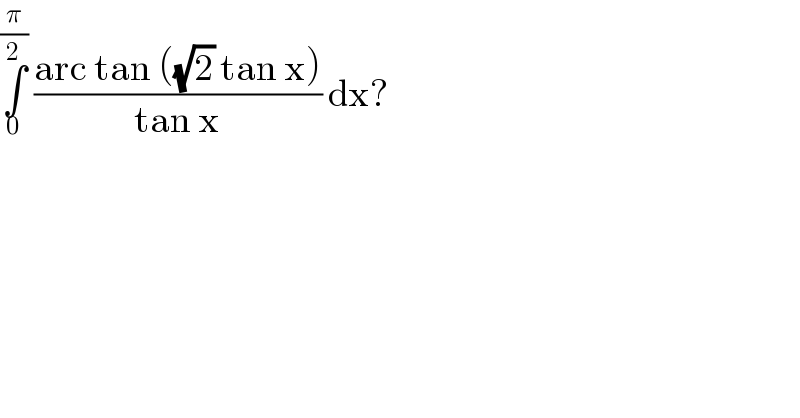Question Number 87025 by john santu last updated on 02/Apr/20

$$\underset{\mathrm{0}} {\overset{\frac{\pi}{\mathrm{2}}} {\int}}\:\frac{\mathrm{arc}\:\mathrm{tan}\:\left(\sqrt{\mathrm{2}}\:\mathrm{tan}\:\mathrm{x}\right)}{\mathrm{tan}\:\mathrm{x}}\:\mathrm{dx}?\: \\ $$
Commented by mathmax by abdo last updated on 02/Apr/20

$${let}\:{f}\left({a}\right)\:=\int_{\mathrm{0}} ^{\frac{\pi}{\mathrm{2}}} \:\frac{{arctan}\left({atanx}\right)}{{tanx}}{dx}\:\:{with}\:{a}>\mathrm{0} \\ $$$${f}^{'} \left({a}\right)\:=\int_{\mathrm{0}} ^{\frac{\pi}{\mathrm{2}}} \:\frac{{tanx}}{\left(\mathrm{1}+{a}^{\mathrm{2}} {tan}^{\mathrm{2}} {x}\right){tanx}}{dx}\:=\int_{\mathrm{0}} ^{\frac{\pi}{\mathrm{2}}} \:\frac{{dx}}{\mathrm{1}+{a}^{\mathrm{2}} {tan}^{\mathrm{2}} {x}} \\ $$$$=_{{atanx}\:={t}} \:\:\:\:\int_{\mathrm{0}} ^{+\infty} \:\:\frac{\mathrm{1}}{\mathrm{1}+{t}^{\mathrm{2}} }×\frac{\mathrm{1}}{{a}\left(\mathrm{1}+\frac{{t}^{\mathrm{2}} }{{a}^{\mathrm{2}} }\right)}{dt}\:={a}\int_{\mathrm{0}} ^{\infty} \:\:\:\frac{{dt}}{\left({t}^{\mathrm{2}} \:+\mathrm{1}\right)\left({t}^{\mathrm{2}} \:+{a}^{\mathrm{2}} \right)} \\ $$$$=\frac{{a}}{{a}^{\mathrm{2}} −\mathrm{1}}\int_{\mathrm{0}} ^{\infty} \left(\frac{\mathrm{1}}{{t}^{\mathrm{2}} +\mathrm{1}}−\frac{\mathrm{1}}{{t}^{\mathrm{2}} \:+{a}^{\mathrm{2}} }\right){dt}\:\:=\frac{\pi{a}}{\mathrm{2}\left({a}^{\mathrm{2}} −\mathrm{1}\right)}−\frac{{a}}{{a}^{\mathrm{2}} −\mathrm{1}}\:\int_{\mathrm{0}} ^{\infty} \:\:\frac{{dt}}{{t}^{\mathrm{2}} \:+{a}^{\mathrm{2}} } \\ $$$${we}\:{have}\:\int_{\mathrm{0}} ^{\infty} \:\frac{{dt}}{{t}^{\mathrm{2}} \:+{a}^{\mathrm{2}} }\:=_{{t}={a}\alpha} \:\:\:\int_{\mathrm{0}} ^{\infty} \:\:\frac{{ad}\alpha}{{a}^{\mathrm{2}} \left(\mathrm{1}+\alpha^{\mathrm{2}} \right)}\:=\frac{\mathrm{1}}{{a}}\frac{\pi}{\mathrm{2}}\:\Rightarrow \\ $$$${f}^{'} \left({a}\right)\:=\frac{\pi{a}}{\mathrm{2}\left({a}^{\mathrm{2}} −\mathrm{1}\right)}−\frac{}{{a}^{\mathrm{2}} −\mathrm{1}}×\frac{\pi}{\mathrm{2}}\:\:=\frac{\pi}{\mathrm{2}\left({a}^{\mathrm{2}} −\mathrm{1}\right)}\left({a}−\mathrm{1}\right) \\ $$$$=\frac{\pi}{\mathrm{2}\left({a}+\mathrm{1}\right)}\:\Rightarrow{f}\left({a}\right)\:=\frac{\pi}{\mathrm{2}}{ln}\left({a}+\mathrm{1}\right)\:+{C} \\ $$$${f}\left(\mathrm{0}\right)\:=\mathrm{0}\:={C}\:\Rightarrow{f}\left({a}\right)\:=\frac{\pi}{\mathrm{2}}{ln}\left({a}+\mathrm{1}\right)\:{and} \\ $$$$\int_{\mathrm{0}} ^{\frac{\pi}{\mathrm{2}}} \:\frac{{arctan}\left(\sqrt{\mathrm{2}}{tanx}\right)}{{tanx}}{dx}\:={f}\left(\sqrt{\mathrm{2}}\right)\:=\frac{\pi}{\mathrm{2}}{ln}\left(\mathrm{1}+\sqrt{\mathrm{2}}\right) \\ $$$$ \\ $$
Commented by Ar Brandon last updated on 02/Apr/20

$${cool} \\ $$
